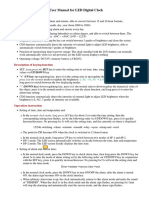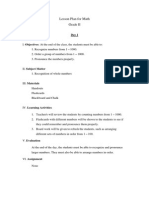Math Week 3 W-F
Uploaded by
api-222266353Math Week 3 W-F
Uploaded by
api-222266353CHRISTINA & APPOQUINIMINK LESSON PLAN FORMAT AND EXPLANATION
Content Math Date Week of November 5, 2012 Time 12:00-1:00
1. STUDENT LEARNING NEEDS All of these students have Autism and attend a public school in a DAP off-site classroom. All students participate in a separate special education classroom in an integrated setting, where they are served inside the regular classroom less than 40% of the day. All students benefit from a token economy system to promote positive and appropriate behavior, daily class wide cash out opportunities, as well as periodic school wide PBS activities, social stories, and verbal reminders of classroom rules. All students also have a point card to help them remember to follow classroom rules. All students have IEP goals for ELA regarding reading comprehension and fluency. All students have IEP goals for Mathematics regarding telling time on an analog clock. Some students have IEP goals for Mathematics regarding addition and subtraction facts. All students have IEP goals for Communication regarding re-telling, and interaction. These students benefit from the use of a manipulative when introducing a concept and visual aids. Repetition will also aid in their learning process. Three students are in second grade and two students are in third grade. Students are working on a second grade curriculum. One student uses a binder to write on as requested by his/her parents. There are no other physical limitations for this group of students. Special Needs Students: Category Students with IEPs English Language Learners (ELL) Gifted 504 Autism or other special needs Number of Students 5 Accommodations and/or pertinent IEP Objectives All students have IEPs written by their previous DAP teacher, speech therapist, and psychologist.
All students are in specialized support DAP classroom with a special education teacher, and para-professional. Students work on the district-wide curriculums with additional resources and activities.
PRIOR LEARNING Students have strong foundational skills in addition when the highest number is twelve as a result of prior instruction. Many students have mathematical facts with two-addends memorized. The students feel comfortable with concrete math facts. They are assessed on their addition facts every week as required in their IEPs.
Students may make errors when adding bigger numbers that are equal to a higher sum.
SOCIAL/EMOTIONAL DEVELOPMENT During this lesson students will be able to not only interact with the teacher but also their peers. The use of a manipulative provides them with the opportunity to engage in small/ quiet social interactions with the teacher and their peers. Students are able to share materials and work when directly prompted. Some may want to share what they have worked on. Some students in the group will not volunteer to discuss their work with the class. For these students, the teacher will call on them and request to see their work. The use of a manipulative allows students to produce hands-on work that can be assessed and shared. ACADEMIC LANGUAGE Add Addend Sum Commutative Property Zero Property Addition Sentence
2. COMMON CORE STANDARDS or STATE STANDARDS CC.2.OA.2: Fluently add and subtract within 20 using mental strategies. By end of Grade 2, know from memory all sums of two one-digit numbers. 3. E.A.T.S FORMAT ESSENTIAL QUESTION How can we use the Commutative Property and the Zero Property to find sums? ACTIVATING STRATEGY 5-Minute Check The teacher will post the following on the easel and work through with students 1. 2, 4, 6, 8,1012 2. 5, 10, 15, 20, 2530 TEACHING STRATEGIES Review Vocabulary (on sentence strips) Add: To join together sets to find the total or sum Addend: Any number or amount being added together Sum: The answer when you add numbers Practice identifying the parts of an addition sentence on the easel. Let students pick numbers. Complete around 4 examples, more if necessary. Pass out counting cubes to each student. Have them make a number sentence that we worked on from the easel. Have them identify the different parts (addend, sum) of the addition sentence that they created. Introduce Commutative Property: Commutative Property: the order of numbers when being addend has no effect on the sum
You can add the numbers, or addends, in any order and you will still get the same sum. Do examples on the board. Teacher picks first addition sentence. Let students pick other addition sentences. Have students identify parts of the addition sentence as well. Introduce Zero Property: Zero Property: zero added to any addend, or number, is the other number. 3+0=3, 100+0=100, 435+0=435 Zero + # = # Do a few examples of the Zero Property on the easel. Have students give examples. Have students identify the parts of the addition sentences. Complete pages 55 and 56 in student book together Complete skill pages 6, 7, 8, 9, 10
Summarizing Strategies (Closure) Explain to students that doing addition is similar to solving a puzzle. o You need to know which numbers, or addends, to add and you have to know what they are equal to, or what the sum is. o You also need to know that the order of the numbers, or addends, doesnt matter and that when you and zero to a number, or addend, the answer will always be the other addend. Explain that before we finish math the students have to complete a puzzle. The students will have to know the different parts of an addition sentence and what the commutative and zero properties are in order to complete the puzzle. Once they complete the puzzle they may mark their point cards for math. 5. RESOURCES AND MATERIALS Counting Cubes Page 55, 56 in student book Skills Pages 6,7,8,9,10 Commutative Property Puzzle Zero Property Puzzle 6. CLASSROOM MANAGEMENT/DEMOCRATIC PRACTICES The students point cards are out on their desks. If they need to color in a circle for bad behavior they will be told to do so. One student has a happy face card. When the student loses both happy faces (for copying another students behavior) he will color in a circle. The happy face chart is to make the student aware that he is behaving in a way that is not appropriate. The chart is also used to notify the student who is being copied that the teacher recognizes the issue and is dealing with it. That specific student should be expected to display the copying behavior during this time period. Wait time and calling on each student will be utilized during this lesson to make sure that each student is getting a chance to participate. The teacher will also go over our classroom rules prior to beginning the lesson as a warning for all students.
You might also like
- Codi Byte - Chat GPT Bible - 10 Books in 1_ Everything You Need to Know About AI and Its Applications to Improve Your Life, Boost Productivity, Earn Money, Advance Your Career, And Develop New Skills.92% (25)Codi Byte - Chat GPT Bible - 10 Books in 1_ Everything You Need to Know About AI and Its Applications to Improve Your Life, Boost Productivity, Earn Money, Advance Your Career, And Develop New Skills.447 pages
- Basc3 Behavior Assessment System for Children, Third Edition Manual I100% (6)Basc3 Behavior Assessment System for Children, Third Edition Manual I188 pages
- Self-Guided EMDR Therapy Workbook Healing From Anxiety, Anger, Stress, Depression, PTSD Emotional Trauma (Katherine Andler)100% (16)Self-Guided EMDR Therapy Workbook Healing From Anxiety, Anger, Stress, Depression, PTSD Emotional Trauma (Katherine Andler)54 pages
- Case Study 1.2 The Hokies Lunch Group - Edited67% (9)Case Study 1.2 The Hokies Lunch Group - Edited4 pages
- Every Brain Needs Music The Neuroscience of Making and Listening To Music100% (11)Every Brain Needs Music The Neuroscience of Making and Listening To Music289 pages
- Building Better Habits With The Habit Loop: 1. CUE 2. Craving91% (65)Building Better Habits With The Habit Loop: 1. CUE 2. Craving1 page
- Foxfire 5 Ironmaking, Blacksmithing, Flintlock Rifles, - Wigginton100% (10)Foxfire 5 Ironmaking, Blacksmithing, Flintlock Rifles, - Wigginton516 pages
- Elementary Education Program Danielson Framework Lesson Plan TemplateNo ratings yetElementary Education Program Danielson Framework Lesson Plan Template8 pages
- How To Diagnose and Repair Automotive Electrical Systems82% (28)How To Diagnose and Repair Automotive Electrical Systems135 pages
- Math Whole Group Teach and Reteach LessonNo ratings yetMath Whole Group Teach and Reteach Lesson19 pages
- Indiana Wesleyan University Elementary Education Lesson Plan Math - Lauryn ScheskeNo ratings yetIndiana Wesleyan University Elementary Education Lesson Plan Math - Lauryn Scheske4 pages
- EED 102 Lesson Plan in Mathematics 3 AutosavedNo ratings yetEED 102 Lesson Plan in Mathematics 3 Autosaved8 pages
- Henderson Addition Strategies Intro - 2nd GradeNo ratings yetHenderson Addition Strategies Intro - 2nd Grade10 pages
- EDUC 2220-Educational Technology Lesson Plan Template Math!No ratings yetEDUC 2220-Educational Technology Lesson Plan Template Math!6 pages
- Elementary Education Lesson Plan TemplateNo ratings yetElementary Education Lesson Plan Template11 pages
- Differentiatedlesson Rbrady For PortfolioNo ratings yetDifferentiatedlesson Rbrady For Portfolio9 pages
- Grade Level Being Taught: 2nd Subject/Content: Math Group Size: Whole Date of Lesson: Mar. 2, 2021No ratings yetGrade Level Being Taught: 2nd Subject/Content: Math Group Size: Whole Date of Lesson: Mar. 2, 20218 pages
- Asw Project Laura Welker EDEL 311 University of Nevada Las Vegas College of EducationNo ratings yetAsw Project Laura Welker EDEL 311 University of Nevada Las Vegas College of Education23 pages
- Inductive Lesson Subject(s) : Math Grade: First Teacher(s) : Cassie Mayer School: Andersen Elementary DateNo ratings yetInductive Lesson Subject(s) : Math Grade: First Teacher(s) : Cassie Mayer School: Andersen Elementary Date10 pages
- 2 Lesson Participation and Observation Assignment Description 08No ratings yet2 Lesson Participation and Observation Assignment Description 085 pages
- CT Lesson Plan Differentiated InstructionNo ratings yetCT Lesson Plan Differentiated Instruction7 pages
- Teacher Candidate Name: Sarah Black Grade Level: 1 Subject: Math-Addition and Subtraction Word Problems Date: 3/28/18No ratings yetTeacher Candidate Name: Sarah Black Grade Level: 1 Subject: Math-Addition and Subtraction Word Problems Date: 3/28/1813 pages
- Lesson Plan 1: Grade/Subject: 1/math Unit: Addition Lesson Duration: 40 Mins100% (1)Lesson Plan 1: Grade/Subject: 1/math Unit: Addition Lesson Duration: 40 Mins28 pages
- FRIT 7739 - Technology Enhanced Unit - WeeksNo ratings yetFRIT 7739 - Technology Enhanced Unit - Weeks15 pages
- Lesson Participation and Observation 1 PDFNo ratings yetLesson Participation and Observation 1 PDF11 pages
- Grade 1: Unit 1.OA.B.3-4 Properties of Operations & The Relationship Between Addition & SubtractionNo ratings yetGrade 1: Unit 1.OA.B.3-4 Properties of Operations & The Relationship Between Addition & Subtraction25 pages
- Examples of PDP Goals: (Used Successfully by MMSD Educators and Others)No ratings yetExamples of PDP Goals: (Used Successfully by MMSD Educators and Others)3 pages
- Module 002 Authentic Assessment: Characteristics and PracticesNo ratings yetModule 002 Authentic Assessment: Characteristics and Practices9 pages
- University Supervisor Student Teacher Eval FormNo ratings yetUniversity Supervisor Student Teacher Eval Form3 pages
- Regional Demo Teaching in Science-Nilo@Amontay0% (1)Regional Demo Teaching in Science-Nilo@Amontay3 pages
- Maligaya Elementary School: Republic of The Philippines Department of Education Region III Division of City SchoolsNo ratings yetMaligaya Elementary School: Republic of The Philippines Department of Education Region III Division of City Schools2 pages
- Department of Education: Guitnangbayan Elementary School100% (1)Department of Education: Guitnangbayan Elementary School4 pages
- 2 Evaluating Idea Lesson Exemplar Final Template Module 2 Session 2100% (1)2 Evaluating Idea Lesson Exemplar Final Template Module 2 Session 23 pages
- Determines The Objectives and Structures of Various Kinds of Reports. Region V BicolNo ratings yetDetermines The Objectives and Structures of Various Kinds of Reports. Region V Bicol2 pages
- Case Study A Tool To Enhance Students' Active Participation in Social Studies ClassNo ratings yetCase Study A Tool To Enhance Students' Active Participation in Social Studies Class3 pages
- Microteaching Lesson Plan (RPP Microteaching)No ratings yetMicroteaching Lesson Plan (RPP Microteaching)3 pages
- Seven School Curriculum Types and Their Classroom Implications - SimplyEducate - MeNo ratings yetSeven School Curriculum Types and Their Classroom Implications - SimplyEducate - Me29 pages
- Cambridge International Certificate in Teaching and Learning (CICTL)No ratings yetCambridge International Certificate in Teaching and Learning (CICTL)21 pages























































































































